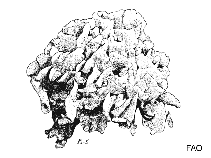Agaricia grahamae Wells, 1973
Graham's sheet coralWarning: DOMDocument::load(): SSL operation failed with code 1. OpenSSL Error messages: error:140770FC:SSL routines:SSL23_GET_SERVER_HELLO:unknown protocol in C:\Apache24\htdocs\includes\SpeciesSummary.lib.php on line 1236
Warning: DOMDocument::load(): Failed to enable crypto in C:\Apache24\htdocs\includes\SpeciesSummary.lib.php on line 1236
Warning: DOMDocument::load(https://sealifebase.nrm.se/webservice/AquaMaps/getAMap.php?genus=Agaricia&species=grahamae): failed to open stream: operation failed in C:\Apache24\htdocs\includes\SpeciesSummary.lib.php on line 1236
Warning: DOMDocument::load(): I/O warning : failed to load external entity "https://sealifebase.nrm.se/webservice/AquaMaps/getAMap.php?genus=Agaricia&species=grahamae" in C:\Apache24\htdocs\includes\SpeciesSummary.lib.php on line 1236
Upload your photos
Google image | No image available for this species;
drawing shows typical species in Agariciidae.
Google image | No image available for this species;
drawing shows typical species in Agariciidae.
Classification / Names Common names | Synonyms | CoL | ITIS | WoRMS
| Scleractinia | Agariciidae
Environment: milieu / climate zone / depth range / distribution range Ecologia
; distribuzione batimetrica 0 - 119 m (Ref. 847). Tropical; 24°N - 25°S, 91°W - 31°W (Ref. 847)
Distribuzione Stati | Aree FAO | Ecosystems | Presenze | Introduzioni
Western Atlantic: Caribbean Sea and East Brazil Self.
Length at first maturity / Size / Peso / Age
Maturity: Lm ? range ? - ? cm
Short description Morfologia
Colonies form flat unifacial explanate plates which are commonly arranged in whorls. Corallites are at the bottom of long, roughly concentric V-shaped valleys. Centers are widely spaced. Septa are thick, do not alternate, and most reach the corallite center. Tan or grey in color, usually with pale margins.
Maximum depth from Ref. 124095.
Life cycle and mating behavior Maturità | Riproduzione | Deposizione | Uova | Fecundity | Larve
Members of the class Anthozoa are either gonochoric or hermaphroditic. Mature gametes are shed into the coelenteron and spawned through the mouth. Life cycle: The zygote develops into a planktonic planula larva. Metamorphosis begins with early morphogenesis of tentacles, septa and pharynx before larval settlement on the aboral end.
Main reference
Bibliografia | Coordinatore | Collaboratori
Bisby, F.A., M.A. Ruggiero, K.L. Wilson, M. Cachuela-Palacio, S.W. Kimani, Y.R. Roskov, A. Soulier-Perkins and J. van Hertum. 2005. (Ref. 19)
IUCN Red List Status (Ref. 130435)
Near Threatened (NT) ; Date assessed: 01 June 2021
CITES status (Ref. 108899)
Appendix II: International trade monitored
CMS (Ref. 116361)
Not Evaluated
Threat to humans
Human uses
| FishSource |
Strumenti
Informazioni ulteriori
Fonti Internet
BHL | BOLD Systems | CISTI | DiscoverLife | FAO(Publication : search) | Fishipedia | GenBank (genome, nucleotide) | GloBI | Gomexsi | Google Books | Google Scholar | Google | PubMed | Hexacorallians of the World | Tree of Life | Wikipedia (Go, ricerca) | Zoological Record
Estimates based on models
Preferred temperature
(Ref. 115969): 27.2 - 28.1, mean 27.7 (based on 90 cells).
Price category
(Ref. 80766):
Unknown.



